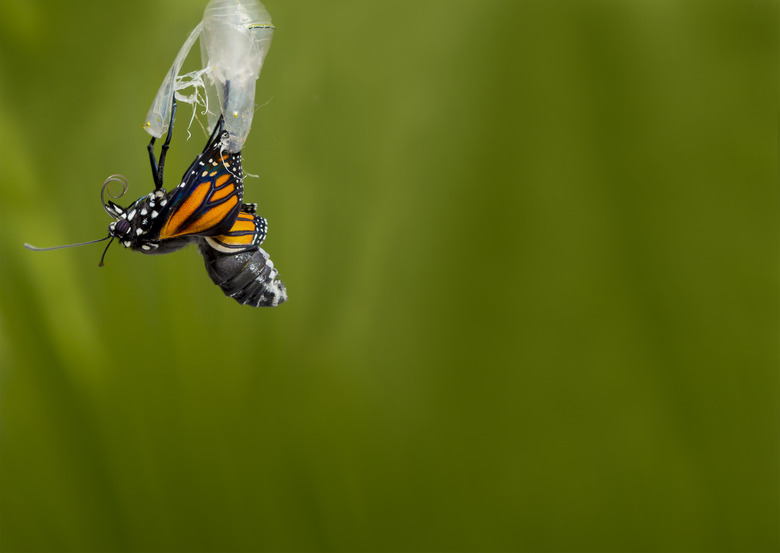How Long Does A Butterfly Stay In A Chrysalis?
Butterflies have fascinated people, including scientists, for generations not only because of their beautifully colored wings but also because butterflies represent the final stage in a fascinating life cycle. Butterflies begin life as caterpillars – wormlike bugs with many legs whose primary purpose is to consume enough energy to create a chrysalis. Inside the chrysalis, the caterpillar's body changes, until it eventually emerges as a butterfly. This process is known as metamorphosis. Most butterflies emerge from their chrysalises in about 10 to 14 days, but butterfly chrysalises vary from species to species.
TL;DR (Too Long; Didn't Read)
Most butterflies take about 10 to 14 days to emerge from their chrysalises, though the color and other characteristics of chrysalises vary from species to species. The chrysalises of monarch, blue morpho and Mechanitis polymnia butterflies vary in several ways.
How a Chrysalis Is Formed
How a Chrysalis Is Formed
The word "chrysalis" is often used interchangeably with the word "cocoon," but the two are not the same. Only butterfly caterpillars form chrysalises, and only moth caterpillars spin cocoons. Unlike a cocoon, which is spun from thread produced by a moth caterpillar, chrysalises exist inside a butterfly caterpillar and emerge once the process of metamorphosis begins. To form a chrysalis, a butterfly caterpillar does not use silk. Instead, it hangs upside down from a leaf or other sturdy structure and sheds the outer layer of its skin. Underneath is a perfectly formed chrysalis, which hardens like a tough outer skin. Inside the chrysalis, the caterpillar's body liquefies and rearranges to form a butterfly. Some butterflies emerge from their chrysalises differently than others.
Monarch Butterflies
Monarch Butterflies
One of the most famous butterflies in the world thanks to their flashy orange wings and migratory habits, the beautiful monarch emerges from an equally beautiful chrysalis. A monarch chrysalis is light green with a series of shimmering, golden dots on the outside. From a distance, this chrysalis could be confused with a shiny, under-ripe fruit, but the monarch chrysalis doesn't stay green for long. After around 10 to 14 days, its green color fades, and the chrysalis becomes transparent. This allows an observer to see the fully formed butterfly within. When the seam along the top of the chrysalis splits, the monarch emerges. Like all butterflies, it is not ready to fly right away. Its wings are crumpled from being folded inside the chrysalis. The butterfly must hang upside down and pump fluid stored in its abdomen up through the veins in its wings to straighten them. Then, the butterfly must wait for the damp wings to dry and harden until they are ready to use.
Blue Morpho Butterflies
Blue Morpho Butterflies
Blue morpho butterflies are native to the tropical forests of Central and South America. These butterflies are famous for their bright, translucent blue wings that appear blue due to reflected light rather than pigment. Like the monarch butterfly, morpho butterflies emerge from a green chrysalis, though a morpho's chrysalis is much plumper and has fewer golden spots. Unlike the monarch's chrysalis, a blue morpho's chrysalis never becomes completely transparent. Instead, the chrysalis becomes partially brown and partially transparent with a milky-white quality just before a blue morpho butterfly is ready to emerge. Amazingly, blue morphos have developed a way to protect themselves from predators even in their vulnerable chrysalis stage. The chrysalis of this butterfly emits a repulsive ultrasonic sound when touched, which drives predators away.
Mechanitis Polymnia Butterflies
Mechanitis Polymnia Butterflies
Mechanitis polymnia butterflies are small, thin-bodied butterflies native to South America. They have small rounded wings, long yellow antennae, and coloration similar to that of monarchs with a bit of yellow and white mixed in. The most impressive stage of the Mechanitis polymnia's life cycle, by far, occurs before the butterfly emerges from its chrysalis. Mechanitis polymnia chrysalises are nearly solid gold with bold black and brown stripes patterned throughout. These metallic chrysalises are what give the butterfly part of its name: mechanitis. It is a reference to the machinelike quality of the highly unusual-looking chrysalises. As strange as the chrysalises may seem, Mechanitis polymnia butterflies emerge in the same way as other butterflies and in the same amount of time – about 10 to 14 days.
Cite This Article
MLA
Cook, Maria. "How Long Does A Butterfly Stay In A Chrysalis?" sciencing.com, https://www.sciencing.com/does-butterfly-stay-chrysalis-cocoon-4572522/. 17 April 2018.
APA
Cook, Maria. (2018, April 17). How Long Does A Butterfly Stay In A Chrysalis?. sciencing.com. Retrieved from https://www.sciencing.com/does-butterfly-stay-chrysalis-cocoon-4572522/
Chicago
Cook, Maria. How Long Does A Butterfly Stay In A Chrysalis? last modified August 30, 2022. https://www.sciencing.com/does-butterfly-stay-chrysalis-cocoon-4572522/
